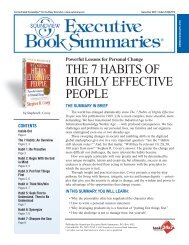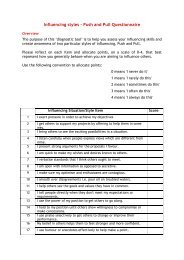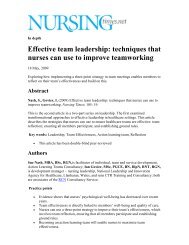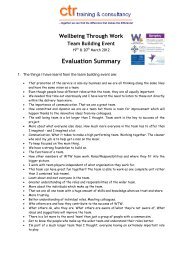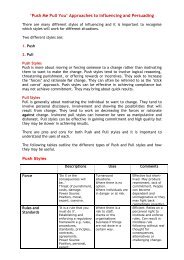The Work of Leadership by Heifetz and Laurie - CTR training and ...
The Work of Leadership by Heifetz and Laurie - CTR training and ...
The Work of Leadership by Heifetz and Laurie - CTR training and ...
You also want an ePaper? Increase the reach of your titles
YUMPU automatically turns print PDFs into web optimized ePapers that Google loves.
the voice <strong>of</strong> the NHS organisations in Wales<br />
Review<br />
<strong>The</strong> <strong>Work</strong> <strong>of</strong> <strong>Leadership</strong> <strong>by</strong> <strong>Heifetz</strong> <strong>and</strong> <strong>Laurie</strong>
<strong>The</strong> <strong>Work</strong> <strong>of</strong> <strong>Leadership</strong> <strong>by</strong> <strong>Heifetz</strong> <strong>and</strong> <strong>Laurie</strong><br />
About Review<br />
Review is a new publication for Welsh NHS Confederation members that aims to provide a literature<br />
review <strong>of</strong> key texts <strong>and</strong> ideas in health <strong>and</strong> related fields written <strong>by</strong> leading edge thinkers from around<br />
the world.<br />
Introduction<br />
As we approach the setting up <strong>of</strong> new unitary health bodies<br />
that will need to be organised <strong>and</strong> work differently from their<br />
predecessors, it is important to hear about others’ views <strong>and</strong><br />
experiences in managing change.<br />
<strong>The</strong> <strong>Work</strong> <strong>of</strong> <strong>Leadership</strong> is an article written <strong>by</strong> <strong>Heifetz</strong> <strong>and</strong> <strong>Laurie</strong><br />
that appeared in the January-February 1997 edition <strong>of</strong> the<br />
Harvard Business Review. It is based on <strong>Heifetz</strong>’s 1994 book<br />
‘<strong>Leadership</strong> Without Easy Answers’, <strong>and</strong> the core principles <strong>of</strong><br />
the article are further extended <strong>and</strong> developed in the 2002<br />
publication ‘<strong>Leadership</strong> on the Line: Staying Alive Through the<br />
Dangers <strong>of</strong> Leading’ <strong>by</strong> Ronald <strong>Heifetz</strong> <strong>and</strong> Marty Linsky.<br />
<strong>The</strong> article discusses the management <strong>of</strong> change <strong>and</strong> focuses<br />
on what is described as “adaptive challenge”, which is about the<br />
locus <strong>of</strong> responsibility shifting to the employees in a company<br />
where an adaptive change is required, <strong>and</strong> how the leader can<br />
help facilitate this.<br />
As Ronald <strong>Heifetz</strong> is a graduate <strong>of</strong> Harvard Medical School, it is<br />
perhaps unsurprising that the article begins with the allegorical<br />
tale <strong>of</strong> a doctor advising a patient <strong>of</strong> what changes <strong>of</strong> habits <strong>and</strong><br />
lifestyle are needed to lead a more healthy <strong>and</strong> better quality<br />
<strong>of</strong> life. <strong>The</strong> doctor is the leader <strong>and</strong> the patient the one who has<br />
the “adaptive challenge” to mobilise <strong>and</strong> make the changes. So it<br />
is in an organisation.<br />
<strong>The</strong> authors regard this role <strong>of</strong> leadership to be the most<br />
difficult. All organisations face adaptive challenges in markets,<br />
competition <strong>and</strong> technology, <strong>and</strong> the nature <strong>of</strong> the required<br />
adaptive work tends to face systemic problems where there are<br />
no obvious <strong>and</strong> easy answers. <strong>The</strong>y suggest that leaders should<br />
get away from the habit <strong>of</strong> providing solutions, <strong>and</strong> devolve this<br />
responsibility to the “collective intelligence <strong>of</strong> all employees”.<br />
<strong>The</strong> role <strong>of</strong> the leader in facing adaptive challenges is to protect<br />
employees from outside threats while allowing the pressures <strong>of</strong><br />
reality to be felt without too much distress – challenging values,<br />
beliefs <strong>and</strong> norms in the process.<br />
<strong>The</strong> six principles<br />
<strong>Heifetz</strong> <strong>and</strong> <strong>Laurie</strong> have identified six principles for leading<br />
adaptive work:<br />
1. Getting on the balcony<br />
2. Identifying the adaptive challenge<br />
3. Regulating distress<br />
4. Maintaining disciplined attention<br />
5. Giving the work back to the people<br />
6. Protecting voices <strong>of</strong> leadership from below<br />
Claiming that leadership is about more than identifying a<br />
vision <strong>and</strong> aligning the workforce with that vision, the first role<br />
in leading an adaptive challenge is the ability to observe <strong>and</strong><br />
mobilise.<br />
While a leader must be able to underst<strong>and</strong> the current business<br />
focus, he or she must also underst<strong>and</strong> the many reactions to<br />
change within the organisation. As if on a balcony with a clear<br />
view <strong>of</strong> all the organisation’s activities, moving back <strong>and</strong> forth<br />
between the “field <strong>of</strong> play” <strong>and</strong> the balcony view will allow the<br />
leader to mobilise the right people in the right way to do the<br />
necessary adaptive work. Without this overview the leader can<br />
become a prisoner <strong>of</strong> the system.<br />
<strong>The</strong> balcony view allows the leader to identify the second<br />
principle, the adaptive challenge needed. <strong>The</strong> authors illustrate<br />
how new adaptive changes can be quite challenging, this time<br />
using the simile <strong>of</strong> a b<strong>and</strong> <strong>of</strong> chimpanzees knowing how to<br />
respond to a threat from a leopard yet not knowing how to<br />
react to a human with a gun.<br />
<strong>Heifetz</strong> <strong>and</strong> <strong>Laurie</strong> move from simile to example in summarising<br />
the account <strong>of</strong> British Airways’ (BA) adaptive challenge in the<br />
1980s. It was during this period when BA’s new chief executive<br />
identified the need to change the values, practices <strong>and</strong><br />
relationships in the organisation to create a greater customer<br />
focus. <strong>The</strong> adaptive challenge was to establish trust throughout<br />
the organisation <strong>and</strong> this was achieved <strong>by</strong> the CEO <strong>and</strong> his team<br />
gaining ideas <strong>and</strong> consensus at all levels, identifying conflicts<br />
as clues to the underlying reality, <strong>and</strong> <strong>by</strong> holding a mirror to<br />
themselves to gain insight as to what was the best <strong>and</strong> worst <strong>of</strong><br />
the company’s values <strong>and</strong> norms.<br />
Describing leadership as a “razor’s edge”, the authors go on to<br />
explain that once the adaptive challenge has been identified,<br />
the leader’s next task is to generate just enough distress among<br />
the people in order that the need for change is felt <strong>by</strong> everyone.<br />
<strong>The</strong>y prescribe three fundamental tasks for a leader to regulate<br />
distress:<br />
• Create a “holding environment” <strong>by</strong> regulating new<br />
initiatives, introducing progress at the right pace.<br />
2
<strong>The</strong> <strong>Work</strong> <strong>of</strong> <strong>Leadership</strong> <strong>by</strong> <strong>Heifetz</strong> <strong>and</strong> <strong>Laurie</strong><br />
• Set direction <strong>by</strong> framing the key questions, protecting<br />
<strong>by</strong> managing the rate <strong>of</strong> change, orienting <strong>by</strong> defining<br />
realities <strong>and</strong> key values, <strong>and</strong> instilling conflict as a means to<br />
creativity.<br />
• <strong>The</strong> leader must be emotionally capable to withst<strong>and</strong><br />
uncertainty, frustration <strong>and</strong> anxiety in order to<br />
communicate confidence.<br />
Maintaining disciplined attention is the fourth principle. Each<br />
employee possesses different experiences, beliefs, values<br />
<strong>and</strong> norms. Using another example from the airline industry,<br />
the authors cite Jan Carlzon, CEO <strong>of</strong> SAS, the Sc<strong>and</strong>inavian<br />
airline in the 1980s: “People can learn their way to collective<br />
solutions <strong>by</strong> underst<strong>and</strong>ing one another’s assumptions”. <strong>The</strong><br />
leader’s role here is to ask questions, reframe the issues, <strong>and</strong> get<br />
conflict out into the open <strong>and</strong> use it as a source <strong>of</strong> creativity.<br />
Teamwork is essential, <strong>and</strong> leaders must demonstrate the<br />
need for collaboration: “Disciplined attention is the currency <strong>of</strong><br />
leadership”.<br />
With principle number five, giving work back to the people, the<br />
authors point out that people in all levels <strong>of</strong> an organisation<br />
possess specialised knowledge <strong>and</strong> information, but the norm<br />
is to rely on senior management to make all the decisions.<br />
<strong>The</strong> argument here is that this leads to complacency <strong>and</strong> the<br />
avoidance <strong>of</strong> responsibility, <strong>and</strong> that leaders should provide<br />
support, rather than control, to allow the people to solve their<br />
own problems. This is turn, leads to a collective self-confidence<br />
based on experience, success <strong>and</strong> the organisational<br />
environment.<br />
<strong>The</strong> sixth principle, is about giving a voice to the people in the<br />
organisation. Again, an example is used to make the point. <strong>The</strong><br />
senior management <strong>of</strong> an organisation encouraged employees<br />
to look for problems, speak openly <strong>and</strong> take responsibility.<br />
One manager took them at their word <strong>and</strong> raised a specific<br />
issue about a project close to the CEO’s heart. With knowledge<br />
<strong>of</strong> the project, the manager had pointed out problems,<br />
outlined competing perspectives <strong>and</strong> provided a summary <strong>of</strong><br />
consequences, only to be admonished <strong>by</strong> the CEO.<br />
<strong>The</strong> learning here is that it is important to underst<strong>and</strong> what<br />
motivates the leaders on the one h<strong>and</strong>, while on the other,<br />
leaders must allow individuals to raise contentious issues <strong>and</strong><br />
ask the question “is there something we are missing?”<br />
<strong>The</strong> six principles for leading adaptive work, outlined in the first<br />
part <strong>of</strong> the article, are witnessed in action in the context <strong>of</strong> a<br />
genuine organisational change process in the final section. <strong>The</strong><br />
authors depict the strategic challenge faced <strong>by</strong> the chairman<br />
<strong>of</strong> KPMG Netherl<strong>and</strong>s in 1994. Although KPMG was pr<strong>of</strong>itable,<br />
there were limited growth opportunities in the sectors it served.<br />
<strong>The</strong> corporate culture at KPMG was likened to a group <strong>of</strong><br />
fiefdoms, with each senior partner being a “lord”; consequently,<br />
any change would be seen as a threat to their control. <strong>The</strong><br />
adaptive challenge would mean a major cultural shift. <strong>The</strong><br />
chairman, rising to the challenge, set about creating the right<br />
conditions to facilitate change. He personally led the initial<br />
communication process through dialogue, beginning with<br />
the senior partners. Building trust, <strong>and</strong> with the involvement<br />
<strong>of</strong> twelve <strong>of</strong> the senior partners, task forces were formed<br />
from within to tackle the adaptive challenge. <strong>The</strong>y looked at<br />
future trends, defining core competencies <strong>and</strong> addressing<br />
the adaptive challenge itself. <strong>The</strong> KPMG corporate culture was<br />
confronted first <strong>of</strong> all, which was described as “developing<br />
opposing views, dem<strong>and</strong>ing perfection <strong>and</strong> avoiding conflict”.<br />
Individuals were rewarded for not failing, <strong>and</strong> business unit<br />
loyalties impeded cross functional problem-solving.<br />
At first, some task forces fell foul <strong>of</strong> this very culture. However,<br />
framing the adaptive changes required for <strong>and</strong> <strong>by</strong> themselves,<br />
they defined the desired culture: “Create opportunities for selffulfilment,<br />
develop a caring environment <strong>and</strong> maintain trusted<br />
relationships with colleagues”. <strong>The</strong> task forces believed in the<br />
process <strong>and</strong> became emissaries, identifying adaptive changes at<br />
the individual level as well as the corporate. <strong>The</strong> level <strong>of</strong> trust in<br />
the organisation rose <strong>and</strong> the collective intelligence was tapped<br />
to solve problems.<br />
<strong>The</strong> nature <strong>of</strong> this change process was in itself distressing, <strong>and</strong><br />
one <strong>of</strong> the chairman’s main concerns became the regulating <strong>of</strong><br />
this distress. Assignments with limited instructions were now<br />
being issued, when previously they had been complex <strong>and</strong><br />
highly structured.<br />
Eventually, attitudes <strong>and</strong> behaviours changed. Hierarchical<br />
power was reduced through increased dialogue <strong>and</strong> teamwork,<br />
with less emphasis on individuals <strong>and</strong> a greater importance<br />
attached to underst<strong>and</strong>ing others’ perspectives. <strong>The</strong> opening up<br />
<strong>of</strong> individual responsibility, the asking <strong>of</strong> questions <strong>and</strong> making<br />
a virtue <strong>of</strong> curiosity became strengths in the new culture. <strong>The</strong><br />
adaptive challenge process unlocked passion <strong>and</strong> creativity.<br />
Leaders <strong>of</strong>ten try to transform an organisation through merger<br />
<strong>and</strong> acquisition <strong>and</strong> re-structuring, treating the whole process<br />
as if it were a technical problem <strong>and</strong> ignoring the main<br />
adaptive challenge. <strong>The</strong> authors observe that leadership is<br />
<strong>of</strong>ten summarised as coming down to a “gr<strong>and</strong> knowing <strong>and</strong><br />
salesmanship”, which ignores the way organisations succeed in<br />
addressing adaptive challenges. Adaptive work involves, <strong>and</strong><br />
adaptive solutions dem<strong>and</strong>, all members <strong>of</strong> an organisation<br />
taking responsibility for the situations that face them. <strong>The</strong><br />
leadership role is to engage people in the adaptive process, <strong>and</strong><br />
it is a leader’s role from whatever position in the organisation to<br />
adjust values, change perspectives <strong>and</strong> learn new habits.<br />
About the authors<br />
Ronald A <strong>Heifetz</strong> is founding director <strong>of</strong> the Centre for Public<br />
<strong>Leadership</strong> at Harvard University’s John F Kennedy School <strong>of</strong><br />
Government. <strong>The</strong> 1994 publication ‘<strong>Leadership</strong> Without Easy<br />
Answers’ is his best-known work .<br />
Donald L <strong>Laurie</strong> is founder <strong>and</strong> MD <strong>of</strong> Oyster International, His best<br />
known work is ‘<strong>The</strong> Real <strong>Work</strong> <strong>of</strong> Leaders’ published in 2000.<br />
3
Unit 3<br />
Waterton Park<br />
Bridgend<br />
CF31 3PH<br />
Tel 0845 33 00 499<br />
E-mail info@welshconfed.org<br />
About the Welsh NHS Confederation<br />
<strong>The</strong> Welsh NHS Confederation represents the organisations making up the NHS in Wales:<br />
trusts <strong>and</strong> local health boards. We act as an independent voice in the drive for better health<br />
<strong>and</strong> better healthcare through our policy <strong>and</strong> influencing work, <strong>and</strong> <strong>by</strong> supporting members<br />
with events, information <strong>and</strong> <strong>training</strong>. To find out more about us go to -<br />
www.welshconfed.org<br />
Registered Charity no. 1090329






